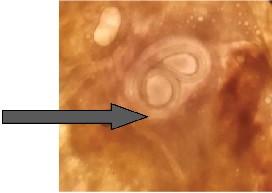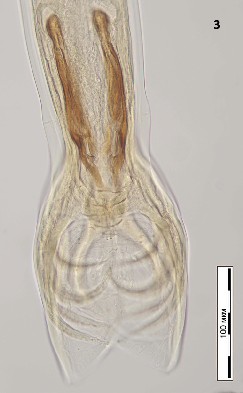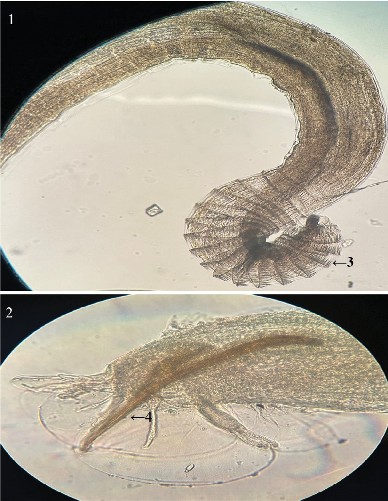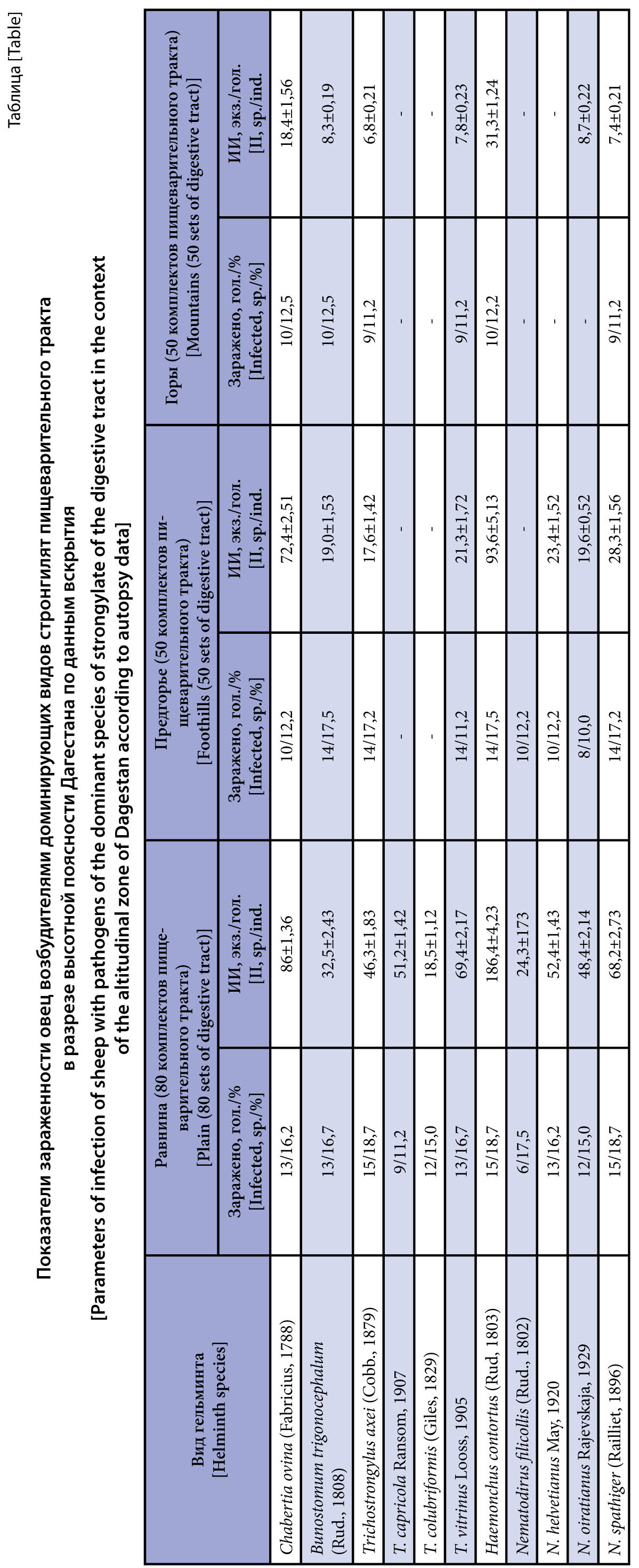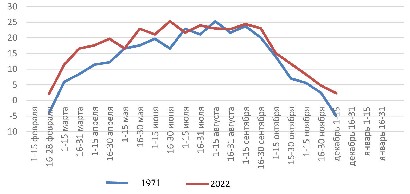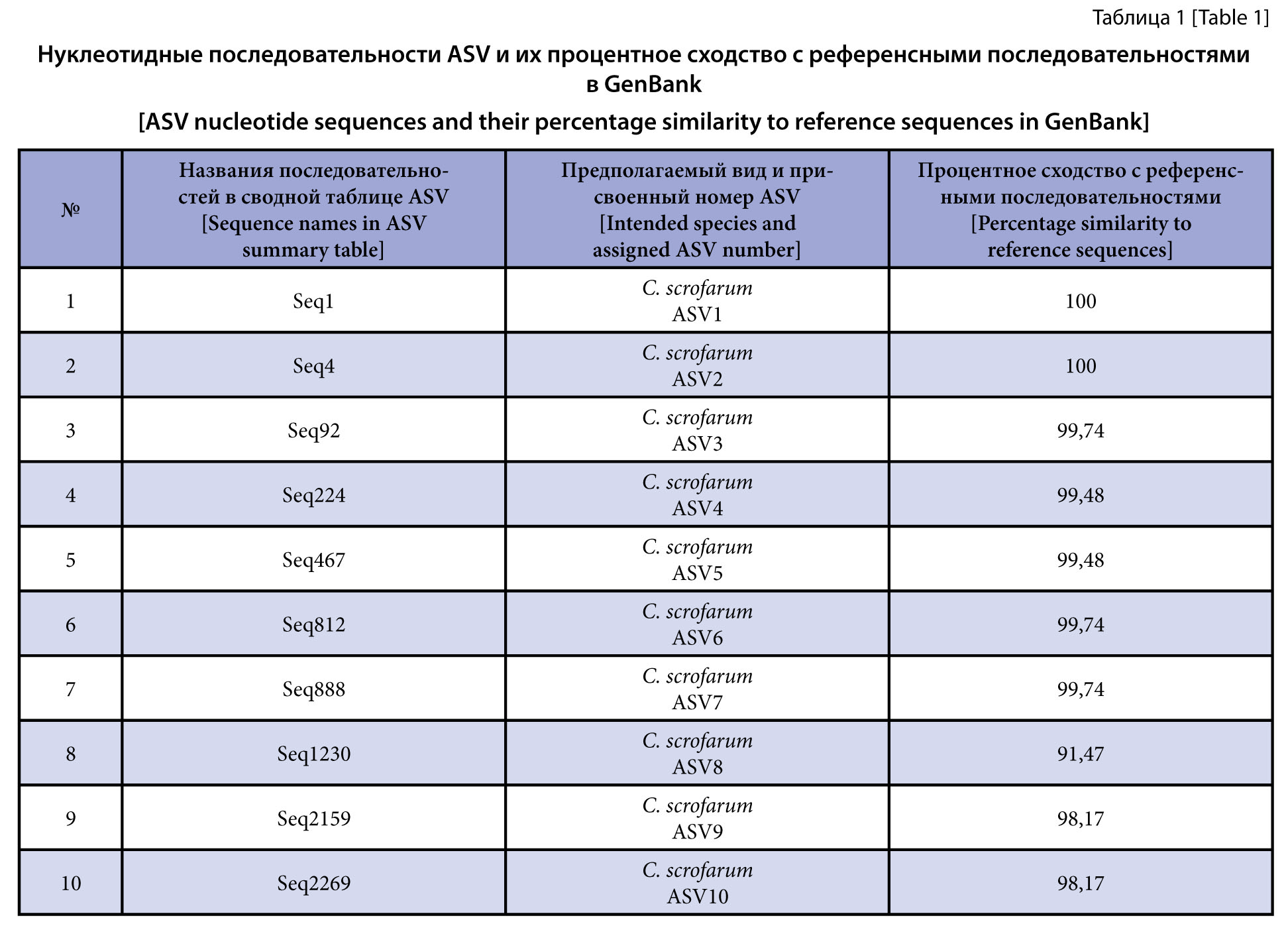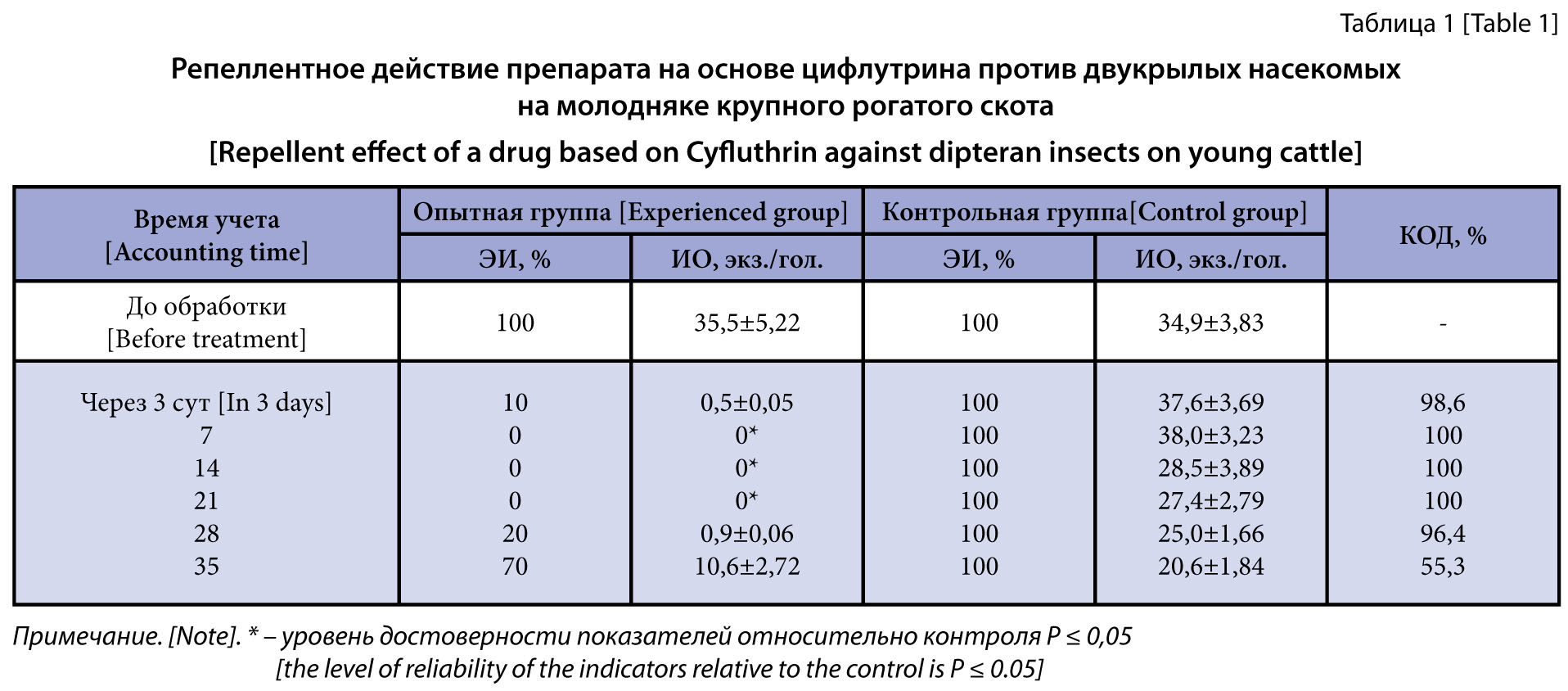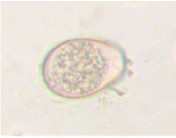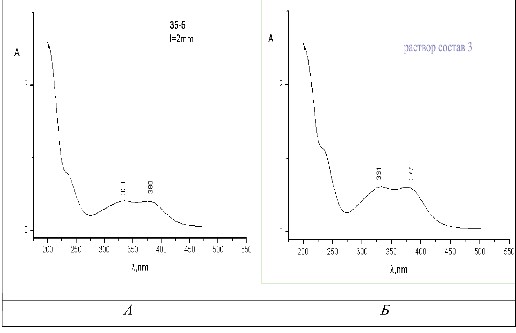OUR ANNIVERSARY
FAUNA, MORPHOLOGY AND SYSTEMATICS OF PARASITES
The purpose of the research is to study the species composition of nematodes dwelling in fish in natural reservoirs and on artificial pond fish farms in Armenia.
Materials and methods. The studies were performed at the Research Center for Veterinary Medicine and Veterinary and Sanitary Expertise of the Armenian National Agrarian University and at the Laboratory of Molecular Parasitology of the Scientific Center of Zoology and Hydroecology from March 2020 to December 2022. Traditional ichthyo-parasitological methods were used to study 246 fish of 10 species from fish farms in the Ararat and Armavir Regions, from Lake Sevan and the Sevjur, Hrazdan, Marmarik, Akhuryan and Debed Rivers, as well as the Yerevan, Aparan and Akhuryan reservoirs. The study results were statistically processed (descriptive statistics) using the BioStat software.
Results and discussion. The fish were found to have four types of nematodes: Contracaecum microcephalum Rudolphi, 1819, Philometroides sanguineus Rudolphi, 1819, Rhabdochona fortunatowi Dinnik, 1933 and Cystidicola farionis Fischer, 1798. Parasites were found in the body, on the serosa, in the air bladder walls, the intestinal lumen and the caudal fin thickness. The total nematode infection rate in fish was 9.76%. The nematode infection rate in fish was characterized by low values of prevalence and intensity other than the infection by the species Rh. fortunatowi (up to 24 specimens per fish). Among the found nematodes, the species C. microcephalum posed a potential threat to human health.
The purpose of the research is to supplement information on the species composition of helminths of the Siberian roe deer.
Materials and methods. Digestive tracts of seven Siberian roe deer (Capreolus pygargus) that died from various causes in Primorsky Krai (Russian Far East) from October 2017 to December 2020 were examined for the presence of helminths. Taxonomic differentiation of detected helminths was carried out basing their morphological peculiarities.
Results and discussion. In all studied individuals of Siberian roe deer, only representatives of Nematoda were found. All of the nematodes were found in the abomasa. No helminths were detected in other parts of the digestive tract. There were found three species of Trichostrongylidae: Spiculopteragia spiculoptera, S. asymmetrica and Mazamastrongylus dagestanica. In addition, one species from Spiruridae, Pygarginema skrjabini, was detected. S. spiculoptera was found in all of the examined Siberian roe deer, thus, this species of nematode showed the highest extensity of infection in the study. The highest intensity of infection was noted for S. asymmetrica. And M. dagestanica was found only in one of the studied Siberian roe deer, in single specimens. P. skrjabini was found in single specimens in two of the studied Siberian roe deer. The species S. asymmetrica was recorded in Siberian roe deer for the first time.
The purpose of the research is to study the species composition of Crenosoma spp. dwelling in the body of wild canines (Vulpes vulpes, Canis lupus, and Canis aureu).
Materials and methods. The research material was 36 wild canines belonging to three species (19 Vulpes vulpes, six Canis lupus, and 11 Canis aureu). The animals were studied using the method of partial helminthological dissections per K. I. Skryabin. The dissections determined the infection intensity (sp./animal) and prevalence (%).
Results and discussion. We studied pulmonary helminth infections of wild animals in the Republic of Ingushetia. The study results showed a high infection rate in wild carnivores. The average prevalence in the animals was 47.2%. The foxes were the most heavily infected (73.6%); they were found to have two Crenosoma spp., Crenosoma vulpis and C. petrowi. The prevalence was 16.6% in wolf, and 18.2% in jackal.
ECOLOGY AND BIOLOGY OF PARASITES
The purpose of the research is to model the pathogen Uncinaria stenocephala in laboratory rodents.
Materials and methods. The material for research was the nematode U. stenocephala. The source of the infection was a domestic dog from the Stupinsky district of the Moscow region. In fecal samples, from 90 to 360 helminth eggs were recorded in 1 g of feces. Helminth eggs were obtained by flotation using the Fulleborn and McMaster method. A suspension of larvae was taken into an insulin syringe to a volume of 1 ml and each dose was counted in a watch glass with a diameter of 8 cm. DBA mice and laboratory Beagle dogs were used in the experiments.
Results and discussion. An oral challenge dose of 100 U. stenocephala (L3) larvae was fatal to laboratory mice. Over the 6th day of life, the animals decreased their body weight by 3 g. With a reduced oral dose, for 7–14 days the animals showed ruffled hair and, in isolated cases, dyspepsia. When the infective material was administered subcutaneously, no clinical signs of infection were observed in experimental rodents. After infecttion of Beagle dogs with U. stenocephala larvae, no clinical picture of nematode parasitism was observed. After 21 days, the first helminth eggs appeared in the feces of carnivorous animals. On the 28th day and beyond, the release of helminth eggs in dogs increased. From 360 to 2370 U. stenocephala eggs were found in 1 g of feces.
EPIZOOTOLOGY, EPIDEMIOLOGY AND MONITORING OF PARASITIC DISEASES
The purpose of the research is to study the epizootology of the dominant gastrointestinal strongylatosis in sheep in different natural zones of Dagestan.
Materials and methods. In 2005–2021, 180 forestomachs of the thin and thick sections of the digestive tract and 600 fecal samples from sheep at the altitude (above 2000 m above sea level) were studied based on dissection results. The study was performed by season among young animals aged up to 1 year, from 1 to 2 years and 3 years and older. The study used methods of complete helminthological dissection per K. I. Skryabin, larvae cultivation in a thermostat at 27 оC, and flotation with a saturated ammonium nitrate solution by Kotelnikov-Khrenov and Berman-Orlov.
Results and discussion. Helminth infections are recorded among sheep annually on lowland, moist, steppe pastures of the plains and foothills in various combinations of multiple infections with the prevalence of 11.2–18.7% and the infection intensity of 18.5–186.4 sp./animal. In the mountain zone at altitudes above 2000 m above sea level, the quantitative and qualitative indicators of helminthosis pathogens were sharply limited. On these lands, dicrocoeliosis, monieziosis, larval echinococcosis, chabertiosis, haemonchosis, and nematodirosis were recorded in sheep with the prevalence of 3.2–10.4% and the infection intensity of 2.4–6.3 sp./animal. Gastrointestinal Strongylata dominate in sheep on all types of pastures in the lowland, foothill, and mountain zones: Chabertia ovina, Bunostomum trigоnocephalum, Trichostrongylus axei, T. capricola, T. colubriformis, T. vitrinus, Haemonchus contortus, Nematodirus filicollis, N. helvetianus, N. oiratianus, and N. spathiger.
The purpose of the research is to study the seasonality of Oestrus ovis infection in sheep depending on the management conditions in the steppe zone of the Stavropol Territory.
Materials and methods. The research to study the botfly flight seasonality was conducted on two farms in the Apanasenkovsky District and two farms in the Ipatovsky District of the Stavropol Territory. The number of sheep botflies was studied in the entire flight season by regular inspection and counting of the parasite adult stage on the outer surfaces of sheephouse walls and the side walls of sheds with a 15 day-interval.
Results and discussion. The sheep botfly flight season was 5.5 months (from May 25–30 to October 31–November 11). Two increases in the number of botflies were observed during this period: in July and September–October. Infection of sheep with oestrosis in 1971 had two peaks (the first, May to June; the second, August to November). Due to the earlier spring 2022, the first peak started in the second half of March and lasted until the first half of July, and the second peak was observed from the second half of August to the end of November.
BIOCHEMISTRY, BIOTECHNOLOGY AND DIAGNOSTICS
The purpose of the research is isolation, identification, and analysis of ASV (Amplicon Sequence Variant) types of Cryptosporidia spp. in pigs in the Vologda Region of the Russian Federation.
Materials and methods. The research has been conducted in the Russian Federation for the first time. The research was conducted on pig farms in the Vologda Region of the Northwestern Federal District of the Russian Federation from January to October 2023. Feces were taken from piglets of various age groups, as well as milking sows. The samples were studied using the equipment of the resource center “Genomic Technologies, Proteomics and Cell Biology” of ARRIAM. Species of the genus Cryptosporidia were identified in fecal samples using high-throughput sequencing of 18S rRNA gene fragment amplicon libraries as obtained from nested PCR followed by “denoising”, sequence combining, and restoring the original phylotypes (ASV, (Amplicon Sequence Variant)).
Results and discussion. Cryptosporidia spp. species were identified in each age group studied. As a result of high-throughput sequencing of the libraries using the Illumina technology, 20 to 100 thousand nucleotide sequences (reads) were obtained for each sample after processing of which a total of 2,372 ASVs were identified. The analysis of the ASV taxonomic affiliation performed with phylogenetic analysis supplemented by an analysis using the blastn algorithm in the GenBank database showed that, in total, 10 ASVs were only present in all studied samples that had high similarity to sequences deposited in the GenBank as 18S rRNA gene fragments of Cryptosporidium scrofarum. Eight ASV types were unique and did not repeat from farm to farm. Probably, these sequences belong to local populations of C. scrofarum subspecies. Of interest is the discovery of a unique Cryptosporidium sequence of ASV8 type which is only 91.47% similar to the closest relative of the genus, which may indicate a rather distant taxonomic relationship. This type of nucleotide sequence can be further described as a new species. All identified unique ASV nucleotide sequences were deposited in GenBank.
TREATMENT AND PREVENTION
The purpose of the research is to study repellent efficacy of Cyfluthrin-based drug against dipterans in young cattle.
Materials and methods. In July to September (the peak of attacks by dipterans), two farm scale trials were conducted on two farms in the Stavropol Territory to study repellent efficacy of Cyfluthrin-based drug against dipterans on young cattle. The examining of the animals at the beginning of the trial found that all of them were attacked by dipterans including horseflies, gadflies, mosquitoes, midges and zoophilous flies with 100% infection prevalence and an abundance index of 23.0–35.5 specimens on one animal. The animals in two study groups received the test drug on dry, intact skin of the back, along the spine from the withers to the rump, once at a dose of 0.2 mL of the drug per 10 kg of animal weight. The drug efficacy was assessed based on a decrease in the number or absence of dipterans in the treated animals as compared to the untreated animals (control groups) before the trial and at day 3, 7, 14, 21, 28 and 35. We used a visual inspection technique and counting of the number of dipterans on an animal for 3 minutes.
Results and discussion. The use of the Cyfluthrin-based drug at a dose of 0.2 mL per 10 kg of animal weight showed a 100% repellent effect against dipterans. The repellent index was in the range of 78.6–96.4% for 28 days, which is higher than 70%, which indicates a high repellent effect of the drug against dipterans.
The purpose of the research is to determine the therapeutic and prophylactic efficacy of long-acting coniferous and phytogenic feed additives against eimeriosis in calves under traditional rearing conditions.
Materials and methods. Eimeriosis of calves aged 50 to 60 days was analyzed on a livestock farm in the Kirovo-Chepetsk District of the Kirov Region from April to May 2023. Coniferous and phytogenic feed additives “Coniferous and phytogenic immune modulator for baby calves” and "Coniferous and salicylic feed additive" (LLC STC Khiminvest) were used as treatment and prevention drugs. To diagnose eimeriosis in calves and monitor the treatment effectiveness, we performed clinical observations, thermometry, and coprological surveys pursuant to GOST 25383-82 as housed by the Diagnostic Laboratory of Veterinary Parasitology of the VSATU.
Results and discussion. The “coniferous and phytogenic immune modulator for baby calves” was found to have 100% therapeutic and prophylactic effectiveness against Eimeria bovis and E. ellipsoidalis dwelling in calves during the motherbonded rearing. The “coniferous and salicylic feed additive” showed a 100% positive effect against E. ellipsoidalis. Due to eating qualities, both feed additives were well eaten by animals and helped to improve diarrhea symptoms.
The purpose of the research is to obtain and test a complex drug Aniverm-2.0% based on the ivermectin substance by free feeding in a mixture with concentrated feed against parasitosis of cattle, sheep, and horses.
Materials and methods. Aniverm-2.0% obtained by mechanochemical technology was tested on a farm in the Shatoy Region, the Chechen Republic, on 900 sheep, 180 cattle and 156 horses in March-April 2023. To determine the infection rate, coproovoscopic examinations were conducted on 80 samples from sheep, 20 samples from young cattle and 30 samples from horses using the Fulleborn’s flotation method with a saturated sodium chloride solution. Sheep were dewormed using a group method. The drug was mixed with feed per 0.3 mg/kg for the AS or 60 mg for the drug per animal. The young cattle were kept by tie-up housing and therefore they were given Aniverm-2.0% once at a dose of 0.2 mg/kg for the AS individually in a mixture with feed. The horses were given the drug in a group method at a dose of 0.2 mg/kg for the AS or 1.5 mg/kg for the drug. Fecal samples from all animals were examined before and 2 weeks after the drug.
Results and discussion. A 100% rate of infection of the sheep by gastrointestinal nematodes (Strongylata, Nematodirus spp., Trichocephalus spp.) was determined with an average number of eggs 633.3 in 1 g of feces. In 20 fecal samples from the young cattle, 16 were found to have Strongylata eggs (prevalence = 80.0%) with 222.2–280.5 specimens of Strongylata eggs found in 1 g of feces. Strongylata eggs were found in all 30 examined fecal samples from the horses, on average, 253.3 specimens/g of feces (100%). At 2 weeks after treatment, nematode eggs were found in three out of 80 examined fecal samples from the sheep, which can be explained that the sheep did not eat the appropriate dose of the drug. The drug efficacy was determined to be 99.7%. One hundred percent efficacy of the drug was obtained on young cattle and horses.
The purpose of the research is to study the effect of insect compost obtained as a result of the vital activity of insects of the Coleoptera order Ulomoides dermestoides on the quantitative and qualitative composition of soil nematodes of various ecological and trophic groups, as well as on the morphological and physiological state of plants and infection of tomato plants with root-knot nematodes.
Materials and methods. Under laboratory conditions, soil containing a diverse fauna of nematodes was treated with 1% dry and 0.5; 0.75 and 1% aqueous solutions of biocompost. Insect compost was obtained by keeping the U. dermestoides on a dry nutrient mixture. Then a mixture of lawn grasses was sown in the ground. After 30 days, the composition of nematodes was analyzed. The ability of insect compost to suppress parasitic nematode species was studied using the tomato-knot nematode model system. Tomatoes were infected with Meloidogyne incognita at a rate of 500 larvae (J2) per plant and simultaneously treated with a 0.5% aqueous biocompost solution.
Results and discussion. The insect compost U. dermestoides has an effect on quantitative and qualitative indicators in the community of soil nematodes, increasing the number of predatory and saprobiotic nematodes and displacing parasitic ones. And due to the content of various biologically active compounds, it affects the development of rootknot nematodes in tomato roots. When tomatoes are treated with an aqueous solution of insect compost, the infection score and the number of nematodes that penetrate the roots are reduced. The introduction of compost when growing a mixture of lawn grasses and tomatoes can improve the condition of the plants.
The purpose of the research is to analyze the dynamics of fenbendazole (FBZ) and niclozamide (NZM) release from their solid dispersions (SD) of various compositions by dialysis through various semipermeable membranes in model systems that correspond to stomach and intestine environments. To evaluate the parasitocidal activity of experimental mixture compositions.
Materials and methods. The study used substances of FBZ and NZM, and the polymer, polyvinylpyrrolidone (PVP). Mechanical processes were carried out in a LE-101 roller mill and an AGO-2 orbital centrifugal mill at different power density levels. The resulting SD of various compositions were studied for solubility. The dynamics of FBZ and NZM substance release from the SD were studied in a laboratory setup consisting of a temperature controlled glass with buffer solutions with pH = 9.18 (intestinal environment) and pH = 1.0 (stomach environment). The substance concentration in the dialysate was determined by HPLC and UV spectroscopy. The resulting complex SD of FBZ and NZM were studied for cestodocidal activity in a laboratory model of hymenolepiosis of white mice.
Results and discussion. It was found that the substances release into a buffer solution with pH = 9.18 from the SD obtained in the roller mill is higher than that of the SD obtained in the AGO activator. The dialysis of the experimental compounds in a model system with a gastric juice medium observed only FBZ substance penetration through the membrane, which can be explained by protonation of the FBZ molecule which is a weak base. The NZM molecule, being a neutral molecule, does not penetrate through the semi-permeable partition into the hydrochloric acid environment; it remains entirely inside the dialysis bag. High anthelmintic efficacy rates (up to 100%) of SD complex FBZ : NZM : PVP obtained in the AGO activator and in the roller mill were recorded for the SD of composition 2 : 20 : 78 in the mice with hymenolepiosis. The activity of the base drug, the niclozamide substance, was 27.69%, which is 3 times lower than the activity of the resulting complex dispersions.
THE MEMORY OF THE SCIENTIST
ISSN 2541-7843 (Online)




